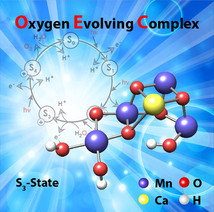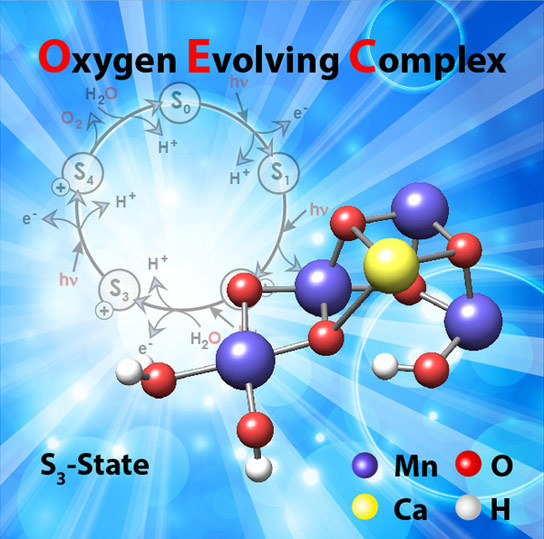/ News

The Prospects for the Development of Clean Fuels Are Improving

The structure of the manganese cluster as it is found in nature and prior to O-O bond formation. In the background, the water-splitting cycle with the intermediate states S0 to S4. Diagram: MPI for Chemical Energy Conversion
New insights into the details of photosynthetic water splitting have provided a blueprint for synthetic systems that could store sunlight energy in chemical energy carriers.
Society’s energy supply problems could be solved in the future using a model adopted from nature. During photosynthesis, plants, algae and some species of bacteria produce sugars and other energy-rich substances (i.e. fuels) using solar energy. A team headed by researchers from the Max Planck Institute for Chemical Energy Conversion in Mülheim an der Ruhr is currently developing experimental methods to ascertain how this process occur in nature. The scientists are investigating a particularly important cofactor involved in photosynthesis, a manganese-calcium complex, which uses solar energy to split water into molecular oxygen. They have determined the exact structure of this complex at a crucial stage in this chemical reaction. This has led to a detailed suggestion as to how molecular oxygen, O2, is formed at this metal complex. Through these new insights into photosynthesis, the scientists have provided a blueprint for synthetic systems that could store sunlight energy in chemical energy carriers.
For over three billion years, nature has been using sunlight as its primary energy source in photosynthesis. In the course of this process, plants, algae and cyanobacteria (blue-green algae) use sunlight to split water and produce energy-rich chemical compounds from carbon dioxide (CO2). The end product is carbohydrates which, in nature, act as solar fuels in the living cell. Although the basic reactions involved in photosynthesis has been known for a long time, researchers from the Max Planck Institute for Chemical Energy Conversion in Mülheim an der Ruhr and the Commissariat à l’Énergie Atomique (CEA) in Saclay, France, have now succeeded in explaining important details of the light-induced water splitting process. As a result, they have refined the scientific basis for the generation of environmentally-friendly, low-cost solar fuels through artificial photosynthesis using sunlight and water, a development that could enable society to end its dependency on fossil fuels such as oil, coal and natural gas.
A water splitting catalyst
Light-induced catalytic water splitting takes place at a metal complex which is embedded in a large membrane protein (photosystem II). This complex is composed of four manganese atoms (Mn) and one calcium atom (Ca), which are held together through a network of oxygen bridges (see image). This water-oxidizing or oxygen-evolving complex undergoes a complicated cycle that releases electrons and protons, hence ultimately hydrogen, and molecular oxygen.
In an article published this week in the journal Science, the German-French research team presents the structure of this manganese-calcium complex directly before the production of oxygen. This insight into a key stage of plant photosynthesis is highly significant: it provides a more detailed understanding of the mechanism involved in photosynthesis and will enable the development of synthetic systems for light-induced water splitting based on this model.
The study is the result of a close cooperation between the Departments of Biophysical Chemistry and Molecular Theory at the Max Planck Institute for Chemical Energy Conversion under the leaderships of Wolfgang Lubitz and Frank Neese. Within these departments, Nicholas Cox and Dimitrios Pantazis assembled an interdisciplinary team that aims to gain a better understanding of the molecular details of water-splitting in nature.
Three challenges posed by the research into photosystem II
The first challenge faced by the researchers involved the extraction and purification of photosystem II with a fully intact water-splitting complex from the original organism, a thermophilic cyanobacterium, which is found in hot springs and volcanoes in Japan and is very robust. To fulfil the very stringent requirements regarding the quality of the preparation, the researchers in Saclay had to carry out several years of development work in cooperation with researchers from Japan.
The second challenge the research team encountered concerned the characterization of the manganese complex in photosystem II during the different stages of water-splitting. The researchers from the Biophysical Chemistry Department of the Mülheim-based Max Planck Institute overcame this hurdle with the help of electron paramagnetic resonance (EPR). This technique makes it possible to visualize the distribution of the electrons in a molecule or metal complex and thus provides deep insight into the individual stages of water-splitting. “These measurements generated new information and enabled the solvation of problems concerning the detailed analysis of molecular structures in the reaction cycle that are not accessible using other methods,” says Dr Alain Boussac from the CEA Saclay.
Finally, the third challenge consisted in using the information obtained to produce a complete structural model of the biocatalyst. The calculations necessary for this process were facilitated using new theoretical methods and the supercomputers at the Department of Molecular Theory at the Max Planck Institute. In this way, the researchers succeeded in showing that during the late phase of the reaction cycle, a second water molecule binds next to an active oxygen atom in the complex and releases a proton. This leads to the formation of the O-O bond in the next step.
Fuel from sunlight – copying nature
Thanks to this decoding of the structure and function of the water-splitting catalyst in photosystem II at atomic level, an explanation of the water splitting mechanism is now within reach. This knowledge enables the identification of important criteria for the design of similar synthetic catalysts that split water using environmentally-friendly, low-cost and easily available elements. At present, expensive platinum and other rare metals or metal complexes are widely used for this purpose. This makes the large-scale production of renewable energy carriers (fuels) like hydrogen very expensive, or even impossible.
With the help of bio-inspired catalysts, hydrogen or another solar fuel could be produced cheaply through the combination of solar power devices with water-splitting catalysts for the generation of solar fuels instead of electricity. This would enable the energy sector to overcome the main problems associated with solar power: sunlight is not available around the clock as an energy source, and electricity is not very well-suited for running motor vehicles. In contrast, the solar fuel concept enables the direct storage of solar energy in chemical compounds and, therefore, the use of this energy at any time or place.
“Synthetic solar fuels open up wide-ranging possibilities for renewable energy technologies, in particular for the transport and infrastructure sectors, which are still reliant on fossil fuels,” says Professor Wolfgang Lubitz, Director at the Max Planck Institute for Chemical Energy Conversion. “An efficient light-driven, water splitting catalyst based on common metals such as manganese would represent huge progress here. The insight gained into nature’s water splitting enzyme through this research has laid the foundations for such developments.”
Publication: Nicholas Cox, et al., “Electronic structure of the oxygenevolving complex in photosystem II prior to O-O bond formation,” Science 15 August 2014: Vol. 345 no. 6198 pp. 804-808, DOI: 10.1126/science.1254910
Source: Max Planck Institute
Image: MPI for Chemical Energy Conversion
Source: http://scitechdaily.com/prospects-development-clean-fuels-improving/
/ About us
Founded by Russian entrepreneur Dmitry Itskov in February 2011 with the participation of leading Russian specialists in the field of neural interfaces, robotics, artificial organs and systems.
The main goals of the 2045 Initiative: the creation and realization of a new strategy for the development of humanity which meets global civilization challenges; the creation of optimale conditions promoting the spiritual enlightenment of humanity; and the realization of a new futuristic reality based on 5 principles: high spirituality, high culture, high ethics, high science and high technologies.
The main science mega-project of the 2045 Initiative aims to create technologies enabling the transfer of a individual’s personality to a more advanced non-biological carrier, and extending life, including to the point of immortality. We devote particular attention to enabling the fullest possible dialogue between the world’s major spiritual traditions, science and society.
A large-scale transformation of humanity, comparable to some of the major spiritual and sci-tech revolutions in history, will require a new strategy. We believe this to be necessary to overcome existing crises, which threaten our planetary habitat and the continued existence of humanity as a species. With the 2045 Initiative, we hope to realize a new strategy for humanity's development, and in so doing, create a more productive, fulfilling, and satisfying future.
The "2045" team is working towards creating an international research center where leading scientists will be engaged in research and development in the fields of anthropomorphic robotics, living systems modeling and brain and consciousness modeling with the goal of transferring one’s individual consciousness to an artificial carrier and achieving cybernetic immortality.
An annual congress "The Global Future 2045" is organized by the Initiative to give platform for discussing mankind's evolutionary strategy based on technologies of cybernetic immortality as well as the possible impact of such technologies on global society, politics and economies of the future.
Future prospects of "2045" Initiative for society
2015-2020
The emergence and widespread use of affordable android "avatars" controlled by a "brain-computer" interface. Coupled with related technologies “avatars’ will give people a number of new features: ability to work in dangerous environments, perform rescue operations, travel in extreme situations etc.
Avatar components will be used in medicine for the rehabilitation of fully or partially disabled patients giving them prosthetic limbs or recover lost senses.
2020-2025
Creation of an autonomous life-support system for the human brain linked to a robot, ‘avatar’, will save people whose body is completely worn out or irreversibly damaged. Any patient with an intact brain will be able to return to a fully functioning bodily life. Such technologies will greatly enlarge the possibility of hybrid bio-electronic devices, thus creating a new IT revolution and will make all kinds of superimpositions of electronic and biological systems possible.
2030-2035
Creation of a computer model of the brain and human consciousness with the subsequent development of means to transfer individual consciousness onto an artificial carrier. This development will profoundly change the world, it will not only give everyone the possibility of cybernetic immortality but will also create a friendly artificial intelligence, expand human capabilities and provide opportunities for ordinary people to restore or modify their own brain multiple times. The final result at this stage can be a real revolution in the understanding of human nature that will completely change the human and technical prospects for humanity.
2045
This is the time when substance-independent minds will receive new bodies with capacities far exceeding those of ordinary humans. A new era for humanity will arrive! Changes will occur in all spheres of human activity – energy generation, transportation, politics, medicine, psychology, sciences, and so on.
Today it is hard to imagine a future when bodies consisting of nanorobots will become affordable and capable of taking any form. It is also hard to imagine body holograms featuring controlled matter. One thing is clear however: humanity, for the first time in its history, will make a fully managed evolutionary transition and eventually become a new species. Moreover, prerequisites for a large-scale expansion into outer space will be created as well.
Key elements of the project in the future
• International social movement
• social network immortal.me
• charitable foundation "Global Future 2045" (Foundation 2045)
• scientific research centre "Immortality"
• business incubator
• University of "Immortality"
• annual award for contribution to the realization of the project of "Immortality”.



 LinkedIn
LinkedIn
 LiveJournal
LiveJournal
 Google
Google
 Twitter
Twitter
 Facebook
Facebook
 Я.ру
Я.ру
 ВКонтакте
ВКонтакте
 Mail.ru
Mail.ru